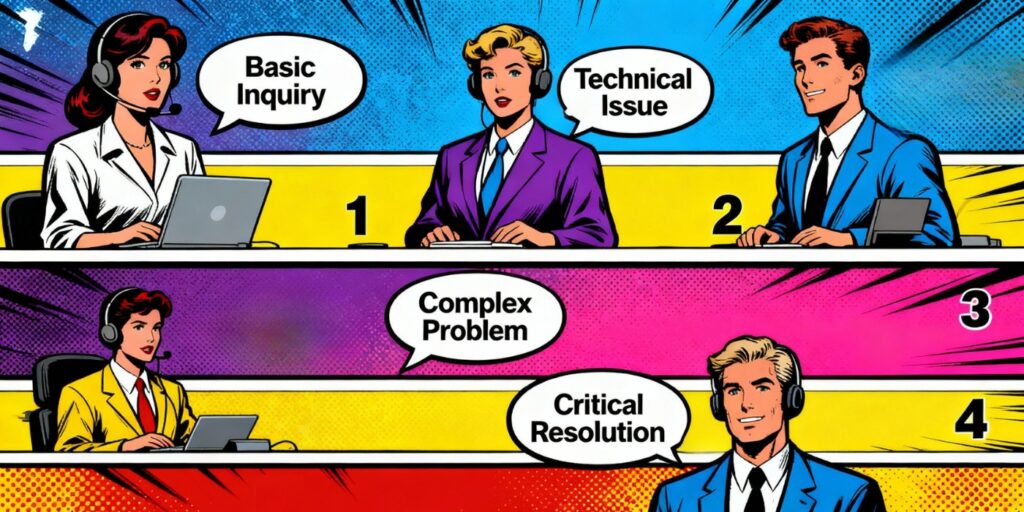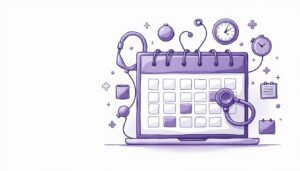Customer Service Tiers: Understanding the Different Key Levels of Support
02 Dec 2023 By: Michael Kansky
Updated
Customer service tiers is crucial for any product or service. It helps users get help with problems or guidance. Support varies in frameworks and level based on the issue’s complexity. This piece explores the various tiered support customer service model and their importance in providing effective help.
What are customer service tiers?
Customer support tiers are levels of help for users. Each level handles different kinds of problems based on how hard they are to fix. This setup helps companies use time and people wisely.
A tier groups support staff by skill. Simple issues go to basic support. Tough ones go higher. This keeps everything organized and fast.
In IT, Tier 1 agents handle common questions and easy fixes. If the issue needs deeper work, they pass it up.
Tier 2 agents or engineers know the product well. They handle harder problems and sometimes work with developers to fix bugs.
The top tier has senior experts. They solve big issues like crashes or major errors. Some may need special training or certifications to give the best help.
Why do organizations use customer service tiers?
Organizations implement tiered support primarily to guarantee that customers are assisted without any delays and in an effective manner. The lower-level support is responsible for dealing with the simpler issues which enables the specialists to focus on the more complicated ones. This method of support results in fewer support levels, shorter wait times, and customers getting the proper help at the right time. It is a good combination of technical know-how and resourcefulness, which leads to a better experience for all parties involved.
Importance of Customer Service Tiers

Using customer service tiers helps fix customer problems faster and better. It makes sure users get help from the right people and keeps them satisfied.
Tiers help companies use their Help Desk smartly. With a good Knowledge Base, agents can quickly find answers to common questions and solve simple issues fast.
Higher tiers handle tougher problems. This way, top agents focus on complex or urgent cases.
Support tiers also help teams grow. As agents learn, they can move up to handle more advanced issues. This improves both their skills and the quality of service.
Exploring the First Tier of Support

First Tier Support: The Frontline of Help
Tier 1, also known as first-level support, is the initial point of contact for users looking for assistance. The agents at this level deal with easy inquiries, provide immediate solutions, and give the most elementary support.
Users reach them through calls, emails, or live chat. Their job is to solve easy issues fast and make sure users feel helped and heard.
The support team staff are analogous to the welcoming committee of the company; they are very friendly, very patient, and they listen very well. They emit good vibes and clarify everything very nicely, thus making the user feel that he/she is very important.
The Tier 1 support may also be provided by an outside agent. This strategy allows the companies to reduce costs and at the same time take advantage of the expertise of the outsourced team without the need to recruit personnel.
What They Do
First-tier agents don’t just solve problems—they represent the company. They build trust, show care, and make sure users leave with a good experience.
They also keep records of each issue and pass complex problems to higher levels when needed.
Skills They Need
Good communication is key. Agents must pay attention, talk plainly, and lead users through the process.
They ought to be very familiar with the product, know the changes, and manage multiple tasks simultaneously.
Patience matters too. Users might be outraged or feel the pressure so remaining cool and nice will certainly be a great help.
The first-level technical support is the bedrock of customer service. Their skill, empathy, and quick help create strong relationships and happy customers.
Second Tier Support: The Tech Experts
The Tier 2 support steps in only when Tier 1 has failed to resolve the issue. The agents are more proficient and handle sophisticated problems that need more skill.
What They Do
Tier 2 digs into the root of tough problems. They check system details, spot patterns, and use advanced tools to find fixes. They often work with other teams to solve bigger issues completely.
Skills and Expertise
These are the real technology pros. They have a very good knowledge of the systems, they are very careful with little things, and they fix problems very fast.
The Tier 2 personnel might be either the company employees or the employees of certain tech companies to whom the services are outsourced. This kind of setup gives the companies not only flexibility but also saves time and makes the additional skills available just when they are needed.
Third Tier Support: The Final Line of Defense
Tier 3, or senior-level support, handles the toughest problems. These are the issues that lower tiers can’t fix.
What They Do
Tier 3 agents take on rare or complex cases. They dig deep into system details, fix code, and repair software. In the majority of instances, they work together with developers and engineers for the solution.
Skills and Expertise
The specialists are well acquainted with the entire product along with its every tiny feature. From the software to the infrastructure. They possess a great deal of talent not just in their capacity as programmers but also as narrators; through collaboration, they manage to share the load of the most difficult challenges even by finding solutions together.
The Final Tier: Specialized Support
Some companies add one more level called specialized support. This tier handles unique or rare problems that need expert attention.
What They Do
Specialized support deals with tasks like database management, network setup, system security, and integrations. It’s for users with complex needs who need help from true specialists.
Skills and Expertise
The agents that make up this team are professionals with vast experience and expert knowledge of the domain. They are certified, very technically knowledgeable, and also great in solving difficult problems. Moreover, they have strong communication skills and possess an ability to perform next to others hence, they provide the best support possible.
What are the benefits of customer service tier system?

A support tier system is a major benefit for companies as it allows them to provide faster, more tailored assistance to their customers. Lower-level teams take care of simple issues and thus they are solved quickly, which means that the experts can work on the more difficult cases. The whole process saves money as it is not only costing the company less to provide the right level of support for each issue but also speeding up the response times. The customers get their help done without waiting for too long which results in a better experience for them. The tier system keeps on changing with the business, thus it becomes less of a hassle to efficiently process more support requests.
Trending now
Fast Company talked about the fact that the establishment of different solution tiers is a way for companies to be in the same place as their customers. The write-up elaborates that through providing several service levels (each with its unique needs, budgets, and skills) firms can do a better job in matching what customers really need. The lower tiers deliver basic tools and minimal support while the top ones provide more intense personalization and professional assistance for difficult problems. This method not only increases customer satisfaction and loyalty but also contributes to the company’s growth by matching the value with each customer’s situation and objectives.
Customer Service Tiers FAQ
What are customer service tiers?
They are levels of support that match issue complexity with agent expertise.
Why do companies use a tiered support system?
It speeds up response times, assigns the right people to each problem, and improves efficiency.
What does Tier 1 support handle?
Simple questions, routine issues, and basic fixes.
When is an issue escalated to Tier 2 or Tier 3?
If Tier 1 can’t resolve it, it goes up to Tier 2 for technical depth or Tier 3 for very complex problems.
What is “specialized support” in the tier model?
A level for niche or rarely occurring challenges requiring expert knowledge (e.g. database, integrations).
Conclusion
The comprehension of distinct levels of customer service gradations is a major factor in providing users with effective assistance. When the support system is delineated into distinct tiers, every client receives the type of help that is most suitable to him/her. This chain of support consisting of a first agent resolving a query to the specialists dealing with advanced matters, the whole hierarchy has its significance in problem-solving, customer delight, and smooth operations.
How about taking your customer support to the next level? By choosing HelpSquad, you will not only get our skilled virtual assistants but also the 24/7 customer service team integrated into your support framework totally trouble-free. Our agents who can speak more than one language are masterly in handling any level of support thus customers of yours are never left without help whenever they need it.
Talk to us today and discover how smarter support tiers can help your business deliver faster, friendlier, and more reliable customer service.


